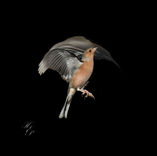_(9240055086).jpg)
The Aviary
"...so now let us make in each soul an aviary stocked with all sorts of birds, some in flocks apart from the rest, others in small groups, and some solitary, flying hither and thither among all the others...We must assume that when we were children this receptacle was empty, and we must understand that the birds represent the varieties of knowledge. And whatsoever kind of knowledge a person acquires and shuts up within the enclosure, we must say that he has learned or discovered the thing of which this is the knowledge, and that precisely this is knowing..." - from Plato's dialogue Theaetetus in which Socrates compares the human mind to an aviary.
Birds have been seen as spirit animals in many cultures. The first known representation of a bird in any form of art is in the Chauvet Cave, France, which is close to 30,000 years old. It is probably a long-eared owl or a Eurasian eagle owl judging from the plumicorns on its head.
Birds of every kind feature prominently in painting throughout Western art history. Byzantine, Gothic and Early Renaissance paintings are rich in philosophical and Christian symbolism regarding birds. The preening peacock, playful finch, scheming vulture, clever crow, a robin, they can all be found in narrative paintings, part of the vivid visual symbolic language that would have been understood by members of society who were unable to read. Feathers and flight helped link men to Heaven.
The earliest known prints of birds date back to the 15th century, when woodblock printing was first introduced to Europe. At the time, bird prints were primarily used for scientific purposes, as they were a way of documenting and studying various bird species. They were therefore highly detailed and as accurate as the illustrator could be. Not all illustrators got to see the birds live and in their natural habitats however, some relying on adventurers to report of bring birds back, so just occasionally misunderstandings and incomplete information lead to an imagined bird was illustrated. As printing technology advanced, bird prints became more accessible to the general public. In the late 19th and early 20th centuries, chromolithography made it possible to mass-produce colourful bird prints, often used for educational purposes. As travel became easier and photography developed the popularity of bird prints waxed and waned. That said, in the mid-20th century, bird prints were certainly being used as decorative items. They were used to add a touch of nature to the sleek and minimalistic interiors created by mid-century modern design. Bird prints have remained a popular subject for collectors.
Birds (scientific name Aves) inspire the work of The House of Embroidered Paper. Below you can see the photographic sketchbook behind the ongoing 300 Years of Shoes collection that is being made in association with Northampton Museum which houses the largest historic shoe collection in the UK.
Please click on each image to enlarge
image copyright Stephanie Smart - The House of Embroidered Paper
Kingfisher
Symbolic of: transformation; resilience; prophetic knowledge; creation; prosperity; freedom; courage; good fortune; adventure

Chaffinch
Symbolic of: joy; renewal; optimism; resurrection; the nativity, picking through the chaff in the manger


Robin
Symbolic of: hope; renewal; rebirth; good luck; happiness; danger
Once believed as the sign of an angel. Sometimes seen as the presence of a lost loved one.

Great Spotted Woodpecker
To identify British woodpeckers and hear them call please click: https://www.woodlandtrust.org.uk/blog/2021/09/british-woodpecker-id/

Woodpecker illustrations: Thomas Bewick (c. 1753 - 1828) English wood-engraver and natural history author © Bewick Society https://www.instagram.com/bewicksociety/
Bluetit
Symbolic of: hope; optimism; renewal; contentment; curiosity; flexibility

Wagtail
Symbolic of: love, said to be a gift from the Goddess Aphrodite
Wagtails have been associated with washing possibly because they tend to be seen around rivers and streams where people would originally have washed objects and clothes. Therefore folklore has attributed them many alternate names such as: willie wagtail; peggy dishwasher.
This is the Grey Wagtail.

Great Tit
Symbolic of: healing; higher thinking; living with intention; keeping your spirits up; protection against evil spirits


Budgerigar
Symbolic of: home and family

Nuthatch
Symbolic of: keeping the faith; trusting what you know

Owls
Symbolic of: wisdom; wealth; good luck; fortune; change; transformation; the shadowy world of the subconscious

Coal Tit
Symbolic of: woodlands; nature; fertility; temptation
Known for their remarkable memories

Dunnock
Symbolic of: humility; modesty; monogamy; loyalty

Wren
Symbolic of: self-worth
Wrens often live in close association with humans. To the Celts they were a sacred bird, the king of the birds and messenger of the gods. Legend says the wren flew further than the eagle in a race to the sun.

House Sparrow
Sparrow - Symbolic of: memory; remembrance; ancestral knowledge.
In art some say that a caged sparrow symbolizes impending death, near a window represents the soul of a loved one recently departed.

Crow
Symbolic of: death; the afterlife; wisdom; intelligence; adaptability; prescience; fortune; destiny, transformation; the future; transformation; change; intuition

Goldfinch
Symbolic of: leaving your concerns and flying; unbridled joy

Blackbird
Symbolic of: reaching higher; great mystery; courage.
Symbolic archetypal figure: the Hero

Duck
Symbolic of: happiness; laughter; nurturing; bonding; good fortune; stability



































































